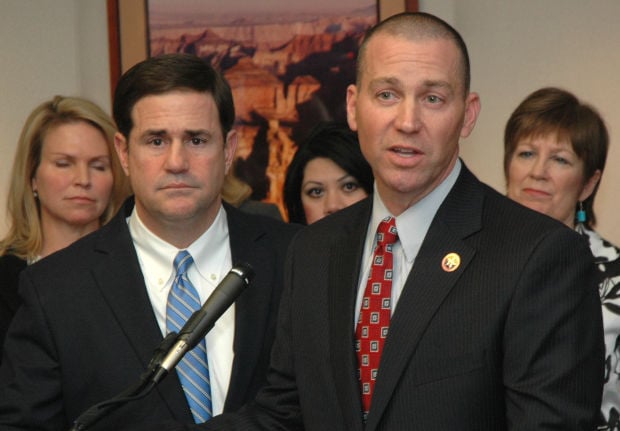A new Arizona auditor general’s report to “pay now or pay later” aims to help the 17,000 children in out-of-home care.
The independent review of the state’s Department of Child Safety, conducted by the Chapin Hall Center for Children at the University of Chicago, was required by the Arizona Legislature when the new department formed more than a year ago. The renamed agency is now overseen by the governor’s office instead of the state’s Department of Economic Security.
The 73-page report, released this week, found that the state’s year-after-year increase in child welfare cases is due largely to its rising poverty rates, especially among children. This, coupled with cuts to funding for day care and other services, has contributed greatly to the number of neglect reports, the report says.
“The well-being of children is tied generally to poverty because families without material resources often struggle to raise children without assistance,” the report says. “In Arizona, the socioeconomic status of families suggests that more and more children were living in vulnerable circumstances.”
The number of newborns to 5-year-olds living in poverty increased in Arizona from 113,000 in 2000 to 148,000 in 2013. Since those are the ages at which children are at greatest risk of coming into contact with the child welfare system, “this increase is an important contextual factor in Arizona.”
Poverty among kids ages 6 to 17 also increased, from 200,000 in 2000 to 273,000 in 2013, the report says.
The report examines how services to help at-risk families appear to be “simply not available” and lead to more removals.
“The perception is that the few services that are available are only for families with severe needs, and have limited capacity and long waiting lists,” the report says.
In 2004, there were slightly fewer than 40,000 reports of maltreatment. In 2009, the number had dropped to 33,228, a decline of about 15 percent. Since 2010, however, reports have increased by about 8 percent per year and hit 48,000 in 2014. That’s a 20 percent increase in 10 years.
Over that decade, the number of substantiated reports of physical abuse in Arizona and nationwide declined. But unlike the rest of the nation, Arizona saw a sharp increase in the number of cases of neglect.
The report offers several suggestions for how Arizona can better help its children:
- Solve problems at the front door, including workforce issues and better assessments, decision-making and referral processes. “Workforce issues are being addressed, although more will need to be done, especially given the number of children in foster care,” the report says. The agency also needs to do more to make hot-line procedures and investigative processes clearer.
Shortfalls in the child welfare workforce of about 25 percent contributes to stress that causes workers to “err on the side of caution and make conservative decisions,” the report says. “At the hot-line, this could mean assigning a higher Priority Level than the case warrants. At investigation, this may mean removing children from their parents’ care when the level of risk may not warrant removal.”
- Strengthen the continuum of services and alternatives to removals so foster care will stop being overused. “If the service array is not expanded or strengthened to prevent entry into foster care and reduce the amount of time children are in foster care, better front-door assessments will become moot,” the report says.
- Strengthen the placement system. This means finding a remedy for the bottleneck that has already formed with 17,000 children needing permanency decisions. “Without adequate resources for the Department and the Courts, at a minimum, it will be hard to avoid a long-term burden,” the report says. “It is very much a pay now or pay later proposition.”
- Cautiously introduce new child abuse prevention programs and strategies supported by scientific research, also called evidence-based practices. The report cautions the agency not to put too much emphasis on these practices until the core problems DCS faces have been addressed.
- Deepen the commitment to accountability and transparency. Without accountability, the report says, “public trust in the agency cannot be restored.”
DCS Director Greg McKay agreed with the recommendations in a letter attached to the report.
DCS spokesman Bryan Pahia said the agency would not respond beyond McKay’s written comments.
Beth Rosenberg, director of child welfare and juvenile justice policy with Arizona’s Children’s Action Alliance, said what she hopes to see now is a plan.
“We are looking for leadership, not only from the department but also from Governor Ducey,” she said. “We need to establish and use clearer child safety assessment protocols.”
Arizona’s lack of preventative services, shortage of permanent homes and several other issues go against national trends, she said.
The report “shares a lot of our thoughts and confirms our concerns about the department,” she said.
Daniel Scarpinato, spokesman for Gov. Doug Ducey, did not respond to emailed questions Wednesday.
Arizona’s child welfare agency, which fell under the state’s Department of Economic Security until January 2014, is not the first to be moved out from under a human services agency. New Jersey and New York City did the same thing in the mid-1990s.
“In New York City, the historical narrative bears a striking resemblance to events in Arizona,” the report says. “The death of a child and ensuing outcry revealed structural problems within the child welfare agency that led then-Mayor Giuliani to create the freestanding Administration for Children’s Services in 1996.”
New Jersey did the same thing a few years later. Both places have since dramatically decreased the number of children in out-of-home care. New York City went from 45,000 in 1996 to fewer than 12,000 today. New Jersey peaked with 12,000 foster children in 2004 and now has fewer than 7,000.





